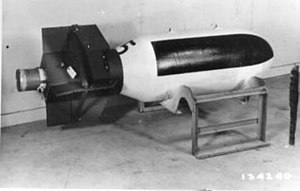AZON
| AZON | |
|---|---|

AZON, the first smart bomb developed by the United States.
|
|
| Type | Smart bombs |
| Place of origin | United States |
| Service history | |
| In service | 1944 |
| Used by | United States |
| Wars | World War II |
| Specifications | |
| Weight | VB-1: 1,000 pounds (450 kg) VB-2: 2,000 pounds (910 kg) |
|
|
|
|
Operational
range |
5,000 feet (1,500 m) |
|
Guidance
system |
MCLOS radio control system |
AZON (or Azon), from "azimuth only", was one of the world's first guided weapons, deployed by the Allies and contemporary with the German Fritz X.
Officially designated VB-1 ("Vertical Bomb 1"), it was invented by Major Henry J. Rand and Thomas J. O'Donnell during the latter stages of World War II as the answer to the difficult problem of destroying the narrow wooden bridges that supported much of the Burma Railway.
AZON was essentially a 1,000 lb (454 kg) general-purpose AN-M65 bomb with a quadrilateral 4-fin style radio controlled tail fin design as part of a "tail package" to give the desired guidance capability, allowing adjustment of the vertical trajectory in the yaw axis, giving the Azon unit a lateral steering capability (meaning it could only steer left and right, and could not alter its pitch or rate of fall). This lack of any pitch control meant that the bombardier still had to accurately release it with a bombsight to ensure it could not fall short of or beyond the target. The "tail package" bolted onto the standard bomb warhead, in place of the usual sheet-metal fixed fins; this concept was an early iteration of a now common method of making modern guided bombs (such as the JDAM, the Paveway family, the KAB-500L, etc): making the guidance and control units as separate pieces that attach to the tail and/or nose of a standard "iron bomb", making it into a guided weapon. There were gyroscopes mounted in the bomb's added tail package that made it an Azon unit, to autonomously stabilize it in the roll axis via operating a pair of ailerons, and a radio control system to operate the proportional-control rudders, to directly control the bomb's direction of lateral aim, with the antennas for the tail-mounted receiver unit built into the diagonal support struts of the tail surface assembly. The bomb's receiver and control system were powered by a battery which had around three minutes of battery life. The entire setup in the added "tail package" was sufficient to guide the weapon from a 5,000-foot (1,500 m) drop height to the target. Situated on the tail of the bomb was a 600,000-candela flare which also left behind a noticeable smoke trail, to enable the bombardier to observe and control it from the control aircraft. When used in combat, it was dropped from a modified Consolidated B-24 Liberator, with earlier development test drops of the Azon in the United States sometimes using the B-17 Flying Fortress as the platform. Some ten crews, of the 458th Bombardment Group, based at RAF Horsham St Faith, were trained to drop the device for use in the European theater.
...
Wikipedia
